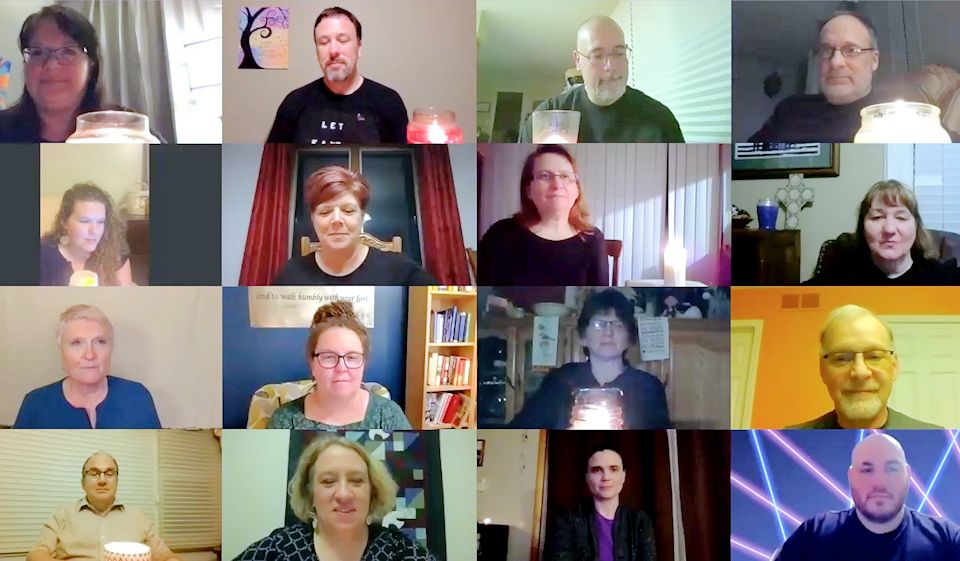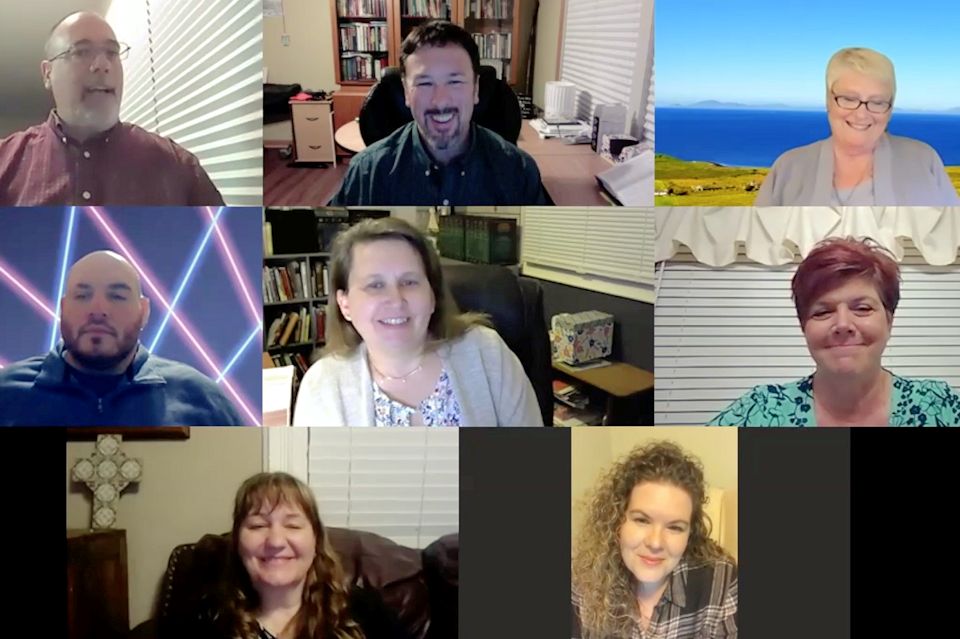Their collaboration began as a way to provide online worship with their congregations. Soon, these pastors learned that the effort was also a source of learning and support for them.
DIANE BROWN
Michigan Conference Communications
When response to the COVID-19 pandemic shuttered businesses, kept non-essential workers at home, and halted in-person worship services, United Methodist Church pastors scrambled to continue ministering with their churches. In just a matter of days, church services moved from inside buildings to broadcasting across electronic platforms.
But what happens when the pastor also is the church technology person, doesn’t have a worship team besides the church musician, and the sanctuary doesn’t have high-speed wireless for internet live-streaming? Could the UMC “connection” help?
“Few of us knew how to do more than record a service, such as uploading and posting,” said the Rev. Matt Osborne, pastor at Ishpeming: Wesley UMC, as he explained the situation in which he and many clergy colleagues found themselves shortly before Easter.
At first, the Rev. Jackie Raineri of DownRiver UMC in the Greater Detroit District thought the transition from in-person services wouldn’t be challenging for her church as they had been live-streaming their services for a year. “But then when more restrictions came, my two tech people stayed home. I’m not tech-savvy at all.”
” … once we got through Easter, it was ‘Now what?’ We couldn’t see when this would wind down. And we were burned out.” ~ Rev. Curtis Clarke
The Rev. Curtis Clarke, the pastor at Marysville UMC, turned to his social media for moral support. “When the shutdown first happened, I scanned through my Facebook list and put together a private group for a way for us to support and encourage each other. We shared resources and became a safe spot to hold one another. This group helped lift each other up. But after four or five weeks and once we got through Easter, it was “Now what?” We couldn’t see when this would wind down. And we were burned out.”
Eight United Methodist clergy in Clarke’s group agreed to create a collaborative electronic Sunday worship experience they each could share with their congregations throughout May. Some were good friends, and others didn’t know anyone in the group. The pastors were from ten churches in seven districts from Ishpeming in the upper peninsula to DownRiver and Convis Union in southern Michigan. They met through Zoom video conference sessions each week to plan a meaningful, but not-too-formal worship service for their congregations.
“We found that folks could only do certain things; for instance, some of us had a music capability but others not,” Clarke said. “[The collaboration] was a way to have a consistent worship experience for all of our ten churches.”
Before the pandemic response restrictions, Osborne thought there was a hesitancy by some churches to invest in digital offerings for fear that it would give people another reason to stay home. “But then we didn’t have a choice; we needed to reach our people, and we had to be creative,” he said. “We ended up getting more people engaged. [Posting our services online is a] non-anxious presence through which to check us out online before coming in the doors.”
In addition to sparking new ideas and energy, the pastors received positive feedback from church members as they were exposed to other clergy across the connection and contemporary worship music not previously heard in their sanctuaries.
Additionally, more people were able to listen to the services at non-traditional times. “We have a group of folks who aren’t available on Sundays because of their work,” Osborne said. “But now they can worship with us. It doesn’t lose meaning if you don’t watch it right at the exact time.”
“It was wonderful to stay connected at a time when we felt very disconnected from everybody.” ~ Rev. Andrea Johnson
For some church members, however, technology and internet access were a challenge to viewing the services.
“We are north of Battle Creek,” the Rev. Andrea Johnson of Convis Union said. “Most people don’t have internet service or cable television out here. The internet network for the parsonage comes from a network based at the local gravel pit. The limitations to technology in a rural area are compounded by the disinterest of many folks about internet.”
Johnson estimated that one-third of her parishioners accessed the collaborative services. But for her, the experience served an even broader need – it was personally fulfilling.
“This gave me a chance to talk about scripture — how we make connection between scripture and life around us,” she said. “I could be part of a worship team. During our prep sessions on Tuesday night, I would be part of a two to three hour discussion. It was wonderful to stay connected at a time when we felt very disconnected from everybody.”
During the first weeks of the restrictions, the Rev. Katie Waggoner at Monroe Heritage and Monroe First UMCs worked to overcome gaps in electronic connections for church members. “We have made like 30 years of technical improvement in a few weeks. I had to set up a YouTube channel, a PayPal account for each church, and a PayPal button for our websites – I am the tech person for my church. We all had very little resources. So, it was nice to share our resources.”

“We found that we had more people watching than would have been in our sanctuaries,” Waggoner said. “Of course, we had out-of-town family and friends watching. But we had others from town who wouldn’t come inside. This can be the baby steps for churches to change, especially if I can get more family members to worship together. It is good “Go Make Disciples” theology. “
Pastors pointed out that the age of clergy or members isn’t always an impediment to adopting new technology. “Some think the older folks won’t adapt to technology,” Clarke cautioned. “I have a 97-year-old Army veteran who has been watching each of our online services.”
But some folks didn’t have a device or internet. Waggoner used creativity to address the shortfall within her congregations. “I reached out via Facebook and asked for inexpensive tablets, new or used so that we can download the services onto them. Many people outside our church responded, even non-Christians. We’re going to take the tablets to those who don’t have internet or smartphones. It is like the old audio cassette tapes we used to take to shut-ins. Tablets will allow more to view online worship and will allow some to stay home and be safe when in-person worship resumes. I feel like this is my gift to the congregation as I depart.”
Waggoner, one of five clergy in the group who will be moving this month to new appointments, has been appointed to Alden and Central Lake UMCs near Traverse City.
Somewhat ironically, Johnson is following Waggoner to Monroe. Through the collaborative services, many members of the two Monroe churches have been watching their new pastor serve alongside their departing pastor.
“I’d like to pursue the collaborative again in Monroe,” Johnson said. “I don’t think COVID is done, and then we head into the flu season this fall. So, we need something online to continue.”
“We’re going to take tablets to those who don’t have internet or smartphones. It is like the old audio cassette tapes we used to take to shut-ins.” ~ Rev. Katie Waggoner
Congregation members at Pinconning and Garfield UMCs gave helpful critiques to their pastor, the Rev. Heather Nowak. “My congregation liked that there was music in the service which they weren’t getting from me. But they didn’t appreciate that they didn’t get to hear from just me. I thank them for allowing me to do this; it was helpful.”
Each Tuesday evening, the collaborative group met via Zoom to discuss the week’s topic and assign the welcome, call to worship, scripture, and prayers. The Rev. Kim Metzer in Mid-Michigan at Hastings Hope kept track of assignments.
The recordings occurred each Wednesday with the week’s message delivered through a roundtable discussion moderated by Osborne or the Rev. Matt West.
Raineri quickly learned that she needed to have multiple talking points prepared for the discussion in case a colleague already used one. “We were good about doing our prep work in advance,” she said, “and the longer we did this, we became more comfortable with each other and the process.”
Music was graciously provided by Joe Rudy, a resident of Indiana, who West met at the As We Are camp at Lake Louise. West, of Girard UMC near Coldwater, also compiled and edited the recordings via iMovie before sending a final file to each church for posting.
Nowak said she also appreciated the collegiality that was formed within the group. “For me, a big benefit was the creative process of talking through scripture with colleagues. Everyone has a different take. It was the highlight of my week for the Zoom call on Tuesday night. It was a support group and encouragement.”
The support value of the group became important for West as well. “On a personal level, it allowed me to focus on some other things like addressing stuff during a pandemic. Collaboration can help so much more than just your service; it is a clergy support tool – we were there for each other, and we knew what each other was going through.”
For future efforts, the pastors concluded that a smaller collaboration of four or five might help give more voice to each person. Also, some thought it would work well for mid-week devotions or small group study. Raineri said, “I’d like to work with a smaller group; perhaps a mid-week offering and go deeper related to that week’s sermon.”
“Collaboration is a clergy support tool – we were there for each other and we knew what each other was going through.” ~ Rev. Heather Nowak
Going forward at Marysville, the church is going to upgrade the sanctuary to provide live-streaming from the sanctuary, Curtis said. Osborne reported that his church would explore upgrading lighting and microphones to improve online offerings.
As West moves to his new appointment at Milan: Marble Memorial, he recognizes the value of continuing the online work. “We’ve spent these last three months for online presence. It would be harmful just to cut it off when we go back to in-person worship. Online is where people are checking us out. It is the gateway that new people are using if they are going to come.”
The pastors appreciated the resources and group bonding despite living hundreds of miles apart. “The value of the United Methodist Church connectionalism was what we represented,” Nowak said. “Our different backgrounds were good, and we weren’t the same theologically. But that was ok. Whatever we didn’t agree on, we knew we were coming together for something beyond ourselves to offer help.”
Osborne said he would encourage other clergy colleagues to consider collaboratives. “It might give you a good place to breathe and have some creativity. We’re becoming collaboration mentors. We learned so much. We weren’t ready to move to digital. But we did it.”
Last Updated on September 20, 2022

